Art deco engagement rings
Art deco diamond ring inspiration and information
Art deco rings are one of the most popular antique engagement ring styles, and for a good reason. Their bold, geometric designs and high-quality of workmanship make them a great choice for a vintage diamond ring.

We’re going to explore the Art Deco Period and all the nuances that make its rings the most popular of the vintage design periods, then find out why so many jewelers still emulate it to this day.
The art deco period
The Art Deco Period, 1915-1935, opened with a World War and ended with one. In between were periods of extremes – from the extravagance of the “Roaring ‘20s” to the poverty of the Great Depression.
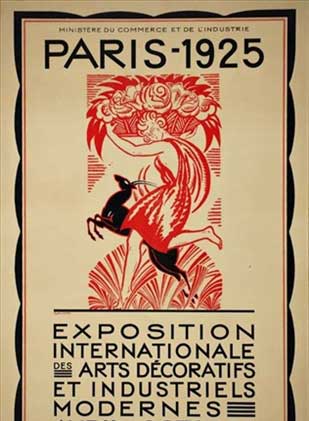
It was also a period of astounding technological advancements. The Wright Brothers’ invention took off and the world cheered on Charles Lindbergh when he completing the world’s first trans-Atlantic airplane flight. Henry Ford began mass producing cars, increasing the supply and lowering the price making cars accessible to everyone, not just the rich.
The term ‘Art Deco’ is derived from the Exposition International des Arts Decoratifs et Industriels Modernes – an art and design event held in Paris in 1925. It celebrated the union of art and modern industry, with an air of shedding stuffy traditions and a move toward modernism and the machine age.
Art deco design
Art Deco was also a period when wealth and opulence became accessible to everyone, not just the rich. The jewelry of this era is indicative of its tone – bold, geometric, glamorous and exciting, accented by large diamonds, vivid gemstones, and intricate craftsmanship.
One of the hallmarks of this design period are simplistic, clean lines and bold, geometric patterns. The metal is minimal with the focal point being the intricate shapes of the diamonds and the contrasting vibrant colours of the accenting gemstones.

This ring is a classic example of the Art Deco Period. The center diamond is a rectangular emerald cut diamond flanked by trapezoid cut diamonds and triangular shaped sapphires.
Round, rectangular, and square shaped diamond and gemstones are centered in mountings surrounded by gemstones arranged in sleek geometric patterns.

Art deco fashion
In WWI, women worked laborious jobs as men were of fighting in the trenches, which meant that fashion changed almost overnight. Dresses had shorter hemlines and shorter sleeves, and women began to wear trousers. Women embraced the freedom these practical styles afforded them and began engaging leisure time activities previously enjoyed only by men – playing sports and throwing back cocktails.
With this celebration of freedom, workers shortened the work day to eight hours which afforded them leisure time. Going to the cinema became a nightly routine and the stars of the silver screen found an ever-widening fan base. Their glamourous lifestyle and wardrobe and jewelry choices were envied and emulated by their fans around the world.
The jewelry of the Art Deco period incorporates geometric patterns with a bold use of diamonds and bright gemstones that’s dramatic and brassy. The age is a marriage of the simplicity of industrial mass-production and the individual creativity of the jewelry artist the world hasn’t seen since.
Vintage Art Deco Engagement Rings
The word ‘antique’ is used to signify jewelry that’s 100 years or older, while the term ‘vintage’ usually refers to rings from a certain design period, like from the Art Deco Period or the Art Nouveau Period.
Ring settings from the Art Deco Period feature geometric patterns, flashy diamonds, and bright gemstones. There was a minimal use of metal for a sleek, unfettered look.
Art deco ring setting Styles
Box setting art deco engagement rings
In keeping with the geometric patterns of the day, this setting gave a square look to the diamond it housed. The four prongs are shaped like triangles with the points forming a square frame around the diamond.

Image: Erstwhile Jewelry
Bezel setting art deco engagement rings
This simplistic setting surrounds the gemstone with a thin wall of metal, holding it secure and providing a measure of protection for the fragile edges of the diamond. This example includes beaded ‘milgrain’ detailing around the edge of the bezel.

Halo art deco engagement rings
Today’s halo style is borrowed from the original Art Deco halo. The Art Deco halo is very dramatic. The diamond is often surrounded by vivid gemstones or the stark black of onyx or even more diamonds for an eye-catching display of glamor.

Invisible setting art deco engagement rings
Perfected by the jewelry house of Van Cleef & Arpels, the invisible setting has gemstones sitting in a hidden metal framework allowing them to sit side-by-side creating a path of gemstones.
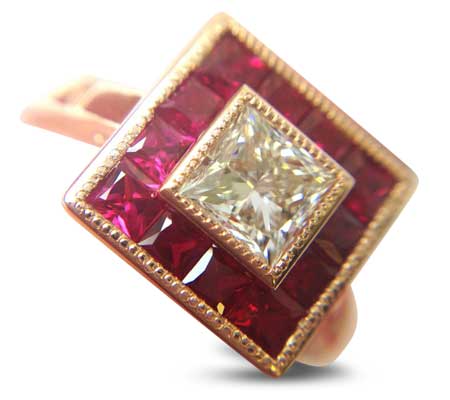
Pavé setting art deco engagement rings
This dainty style features small diamonds set closely together with tiny prongs to create a paved path of diamonds. This setting style is still popular today.

Channel settings
This setting features diamonds or gemstones aligned in a metal groove without prongs. Wedding bands often featured round diamonds or diamonds and sapphires or emeralds in a channel setting. The bands were often worn stacked together.
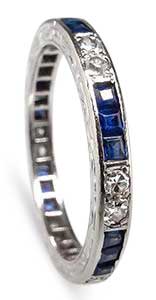
The bold designs and the finely crafted sleekness of the Art Deco Period make it a favorite among vintage engagement ring shoppers.
During the Art Deco period, jewelers and artisans paid attention to detail. Jewelry was finely crafted with milgrain embellishments and intricate filigree work accented the diamonds and gemstones. Even the underside of pieces were finished with as much detail as the top side. There was often engraving along the shanks of the rings.
Milgrain is tiny beads placed along the metal framework of a piece. This ring has milgrain around the diamonds and along the sides and the top of the ring shank:

Art deco jewelry details
This ring has milgrain detailing around the halo setting:

Filigree is open, intricate lattice work through the metal:
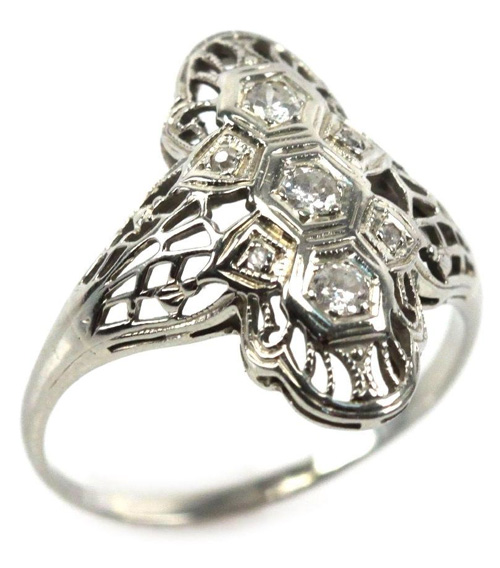
Engraving is etched or carved designs in the metal:

Image: Erstwhile Jewelry
Some rings included all three methods to create really show off the skill of the craftsman who created the ring:

Art deco ring diamonds
Round diamonds in art deco rings
Art deco rings are commonly found with different diamond shapes to the ones that are most common today.
The round cut diamonds seen in Art Deco rings are called the Old Mine cut and the Old European cut. Both are precursors to the modern round brilliant cut diamond and, while the diamond cutters at the time did their best to fashion the diamonds as precisely as possible, the laser-precision cutting of today’s round cut diamonds mean that modern diamonds sparkle much more brilliantly.
On the square-ish side, the Old Mine cut diamond is the older of the two cuts and usually appears in rings dated in the early 1920s. Because cutting diamonds into a square shape salvaged more of the original diamond crystal, diamond cutters produced square diamonds even when they were aiming for a round shape.
However, Art Deco is the age of innovation and diamond cutters started perfecting their trade with technology. This produced a more round diamond than the Old Mine and the resulting diamond cut was called the Old European cut. The Old European cut is a closer relative to today’s round brilliant cut.

Old mine cut

Old English cut

Image: Erstwhile Jewelry
Geometric diamonds in art deco rings
Geometric designs prevailed in Art Deco rings, so emerald cut diamonds and Asscher cut diamonds played a major role in rings from this era. The emerald cut and the Asscher cut are both step cuts; their facets or flat polished surfaces are long and angular. While the emerald is a rectangular shape, the Asscher is a square shape.

This ring features the Asscher cut diamond as well as caliber cut sapphires. Calibre cut was common in this period and it signifies any cut that’s specific to a design. The sapphires on the sides of the Asscher are a strange shape and fit perfectly with the design of the ring. Hence, calibre cut!
Other common diamond cuts used included:
Baguette:

Tapered baguette:

Bullet:

Art Deco Sapphire Rings
The colours of Art Deco are bold, vivid, and contrasting. Jewelers often used brightly coloured gemstones to off-set the brilliance of diamonds. This also occurred in the reverse – they used white diamonds to frame bold gemstones sometimes using obscure gems like lapis and coral and even onyx. The favorite gemstones of the day were the big three – sapphires, rubies, and emeralds.
However, it was the deep blue of the sapphire that was often used to as a complement to the glittering starkness of the diamond. In fact, the sapphire cocktail ring was a popular choice for ladies of this era as were three stone rings featuring a center sapphire flanked by diamonds.

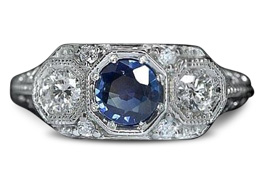
Art Deco Engagement Ring Metals
While yellow gold hadn’t disappeared from the jewelry scene, it definitely took a back seat to the white hot metals in the art deco period. Platinum reigned supreme with 18 and 14 karat white gold running close seconds.
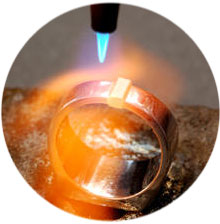
Platinum’s incredible strength allowed jewelers to create intricate pieces without compromising the security of the gemstones or the durability of the piece. This is what allowed the jewelers too create the filigree effect that we saw earlier.
Rings are usually stamped with ‘PT850’ or ‘900plat’ signifying how many parts of 1000 is platinum versus the alloy 850 signifies that a ring is 85% pure platinum, while 900 is 90%. Platinum is usually alloyed with another member of the platinum family, usually iridium or palladium.
White gold and art deco rings
Created to imitate platinum, white gold looks very similar to platinum at first glance, but has vastly different physical properties.
White gold rings will be stamped with ‘18k’ or ‘14k’ signifying what parts of 24k are gold versus the alloy. The metal alloyed with gold is usually nickel to turn the gold to white colour. The ring is then electroplated with rhodium, a member of the platinum family, to intensify the white colour of the gold and strengthening it
Buying an Antique Art Deco Ring
If you are interested in an authentic Art Deco ring, there are many on-line antique dealers who can help you shop.
Even though there are many antique dealers on the internet, shop with stores that specialise in antique jewelry who employ gemologists. In addition to being knowledgeable about the Art Deco Period, these antique dealers can also educate you about other design periods that may interest you.
Also, reputable antique dealers know that each vintage piece is unique and that pictures don’t always capture the piece accurately. Therefore, dealers usually have a return policy in place if you are not satisfied with your item. If this is the case, I recommend calling the dealer immediately after receiving the item to alert them that you are not happy. They usually have a specified number of days when you must return the item for a refund.
Things to Consider when Buying a vintage Art Deco Engagement Ring
Because each ring is unique and dated, there are some things to consider when purchasing an antique.
Difficulty resizing
Rings can only be sized larger or smaller to certain sizes until the integrity of the ring becomes compromised. In addition, many Art Deco rings have hand engraving along the metal and sizing could remove the designs.
More fragile
These are antiques which means they will have wear on them. Prongs could be thin and may need re-tipped. Also, the gemstones could have some abrasions and chipping from years of wear by previous owners.

Diamonds aren’t as brilliant
As we reviewed in the cut styles, diamonds weren’t cut to the precise proportions to produce maximum brilliance like they are today. The diamonds in Art Deco rings will be less sparkly.

Diamonds are warmer
Diamonds were usually worn in the evening in the 1920s and the low lights of the speakeasies masked the yellow body colour of diamonds. As a result, warmer diamonds were acceptable accessories for the stylish flapper girl.

Diamond grading
Many diamonds will not have an diamond grading report. The GIA will not grade a mounted diamond and removing a diamond from its setting could damage the historical correctness of the piece.
My recommendation
If you like the look of authentic Art Deco rings, but aren’t keen on the issues we highlighted, you could opt for a reproduction ring. A reproduction ring is a modern ring fabricated to emulate the style of Art Deco, with modern levels of materials and craftsmanship.
My recommendation here is London Victoria Ring Co. who produce authentic original art deco designs with modern levels or workmanship, materials and service.

They will listen to your ideas, give you guidance, deliver incredible workmanship and stand behind their product with a level of service and value that you will rarely find in any arena.
If you’re looking for an Art Deco ring to wear every day, I recommend you check out London Victoria Ring Co’s selection of Art Deco styles.
